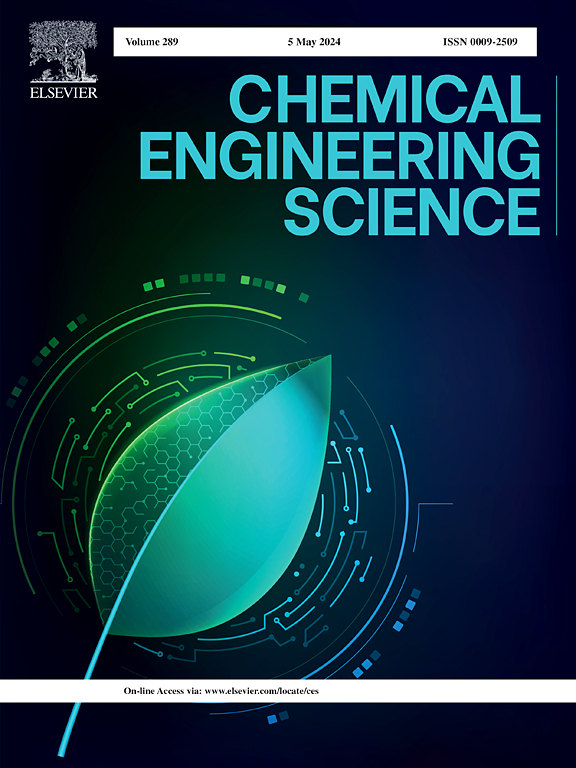液滴在振动混合润湿性表面上的扩散、反弹和迁移特性
IF 4.1
2区 工程技术
Q2 ENGINEERING, CHEMICAL
引用次数: 0
摘要
本文采用实验与数值相结合的方法,研究了液滴撞击振动混合润湿性表面的动力学特性,研究了表面振动频率、初始相位角、振幅和方向对液滴不对称扩散、部分回弹和迁移特性的影响。结果表明,振动参数对撞击后液滴的形态演化有显著影响。在小振幅下,液滴可以保持完整,与静态表面相似,但具有不同的时间和空间尺度。随着振幅的增大,液滴在撞击时发生更大的变形,导致底部劈裂和/或向上破碎。初始相位角φ是液滴撞击动力学的关键决定因素,并与频率相互作用。在垂直振动下,在φ = 270°处液滴的最大扩散系数最大,在φ = 90°处最小。在较宽的初始相位角范围内,垂直振动有增加液滴部分反弹时间和最大高度的趋势。对于所有相位角,液滴在120 Hz频率下的迁移速度都高于静态表面。在φ = 90°处,表面水平振动的平均运移速度低于垂直振动。在较大振幅下,垂直振动在一定频率范围内可以促进液滴迁移,而水平振动则有抑制作用。该研究为科学理解液滴撞击非均质振动表面的动力学提供了有价值的见解。本文章由计算机程序翻译,如有差异,请以英文原文为准。
Spreading, rebounding, and migrating characteristics of a droplet impact on a vibrating hybrid-wettability surface
In this paper, the dynamics of droplet impact on vibrating hybrid-wettability surfaces are investigated through integrated experimental and numerical approaches, and the effects of frequency, initial phase angle, amplitude, and direction of the surface vibration on the asymmetric spreading, partial rebounding, and migration characteristics of droplet are investigated. Results indicate that the morphological evolution of post-impact droplet is significantly influenced by the vibration parameters. At small amplitudes, the droplet can remain intact, evolving similarly to that on a static surface but with different time and spatial scales. As the amplitude increases, the droplet undergoes greater deformation upon impact, leading to bottom splitting and/or upward breakup. The initial phase angle φ is a key determinant of droplet impact dynamics and interacts with frequency. Under the vertical vibration, the maximum spreading factor of the droplet is greatest at φ = 270° and smallest at φ = 90°. Over a wide range of initial phase angles, vertical vibration tends to increase the time of partial rebounding and the maximum height of the droplet. For all phase angles, droplet migration speeds are higher at a frequency of 120 Hz than that on a static surface. Horizontal vibration of the surface results in lower average migration speeds than vertical vibration at φ = 90°. At larger amplitudes, vertical vibration can promote droplet migration within a certain frequency range, while horizontal vibration may exert a suppressive effect. This study could provide valuable insights for a scientific understanding of the dynamics of droplet impacting a vibrating heterogeneous surface.
求助全文
通过发布文献求助,成功后即可免费获取论文全文。
去求助
来源期刊

Chemical Engineering Science
工程技术-工程:化工
CiteScore
7.50
自引率
8.50%
发文量
1025
审稿时长
50 days
期刊介绍:
Chemical engineering enables the transformation of natural resources and energy into useful products for society. It draws on and applies natural sciences, mathematics and economics, and has developed fundamental engineering science that underpins the discipline.
Chemical Engineering Science (CES) has been publishing papers on the fundamentals of chemical engineering since 1951. CES is the platform where the most significant advances in the discipline have ever since been published. Chemical Engineering Science has accompanied and sustained chemical engineering through its development into the vibrant and broad scientific discipline it is today.
 求助内容:
求助内容: 应助结果提醒方式:
应助结果提醒方式:


